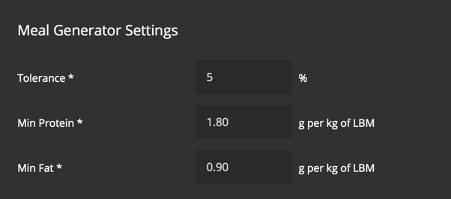Changing Macronutrient Distributions:
General categories:
Generally speaking, the general category and the various alternatives (Vegan, Vegetarian, Pescatarian, Dairy Free, Gluten Free, Vegetarian Gluten Free and Vegetarian Dairy Free), will have a minimum protein of 1.6g per kg of LBM and a minimum fat of 0.8g per kg of LBM.
This is based on current recommendations of protein providing 10 – 35% of total calories and fat providing 20 – 35% of total calories. With this, carbohydrates should also be in line with recommendations (45 – 65% of total calories).
Low Carb categories:
Generally speaking, the low carbohydrate categories and the various deviations of this (Low Carb Vegan, Low Carb Vegetarian, Low Carb Dairy-Free and Low Carb Gluten-Free), will have a minimum protein of 2.1g per kg of LBM and a minimum fat of 1.4g per kg of LBM.
This is based on protein providing 30 – 35% of total calories and fat providing 55 – 60% of total calories. With this, carbohydrates will make up the remaining proportion.
Ketogenic categories:
Generally speaking, our ketogenic category will have a minimum protein of 1.2g per kg of LBM and a minimum fat of 1.8g per kg of LBM.
This is based on fat providing 70 - 80% of the total calories and protein providing 10 – 20% of total calories. With this, carbohydrates will exist in small quantities, making up the remaining proportion.
Tolerance
The other meal generator setting is the tolerance.
Simply, the tolerance is the percentage in which the calories can deviate from the calculated recommendations. Ideally, this should be 5% of less, to ensure the days are not too dissimilar to one another, as well as maintaining numbers close to the goal.
A tolerance of 5% would infer that the meal plan can deviate 5% from the calorie recommendations calculated.
Changing the Macronutrient Distribution for a full category
We appreciate that based on personal beliefs, your clientele, particular goals and multiple other factors, the general guidelines above may need to be tweaked.
This can be done at a category level by simply heading into your platform, clicking the nutrition tab, then categories, then hovering over the specific category that requires updated, and clicking edit. Under Meal Generator Settings you can then replace the current settings with your new settings and then save and publish (at the bottom of the page).
This will mean all of those new meal plans made on this certain category will align with your updated ratios. If there are any active meal plans in this specific category, these will not be automatically updated, they can either be manually updated, or will update when a new meal plan is generated.
Changing the Macronutrient Distribution for an individual
It is also possible that a particular client requests a different macronutrient ratio than what the particular meal plan is providing them.
If they are requesting, say a higher amount of protein and fat and a lower amount of carbohydrates but are in the ‘general’ category, you may want to discuss the other meal plan options you have available. In this particular situation you may suggest that they move to your ‘low carb’ option.
If a specific client is wanting a ratio that does not match any of the current categories available, this is not possible on an individual level.
However, there are two options around this:
- If this is a common request, the macronutrients for the category can be changed as above. However, this will be effective for all those in a certain category.
- If this is not a common request, but the customer is adamant they want this change, the client’s meals can be manually updated to be more in line with the request, or the proportion of the ingredients within the meals can be manually updated to align with their specific request.



